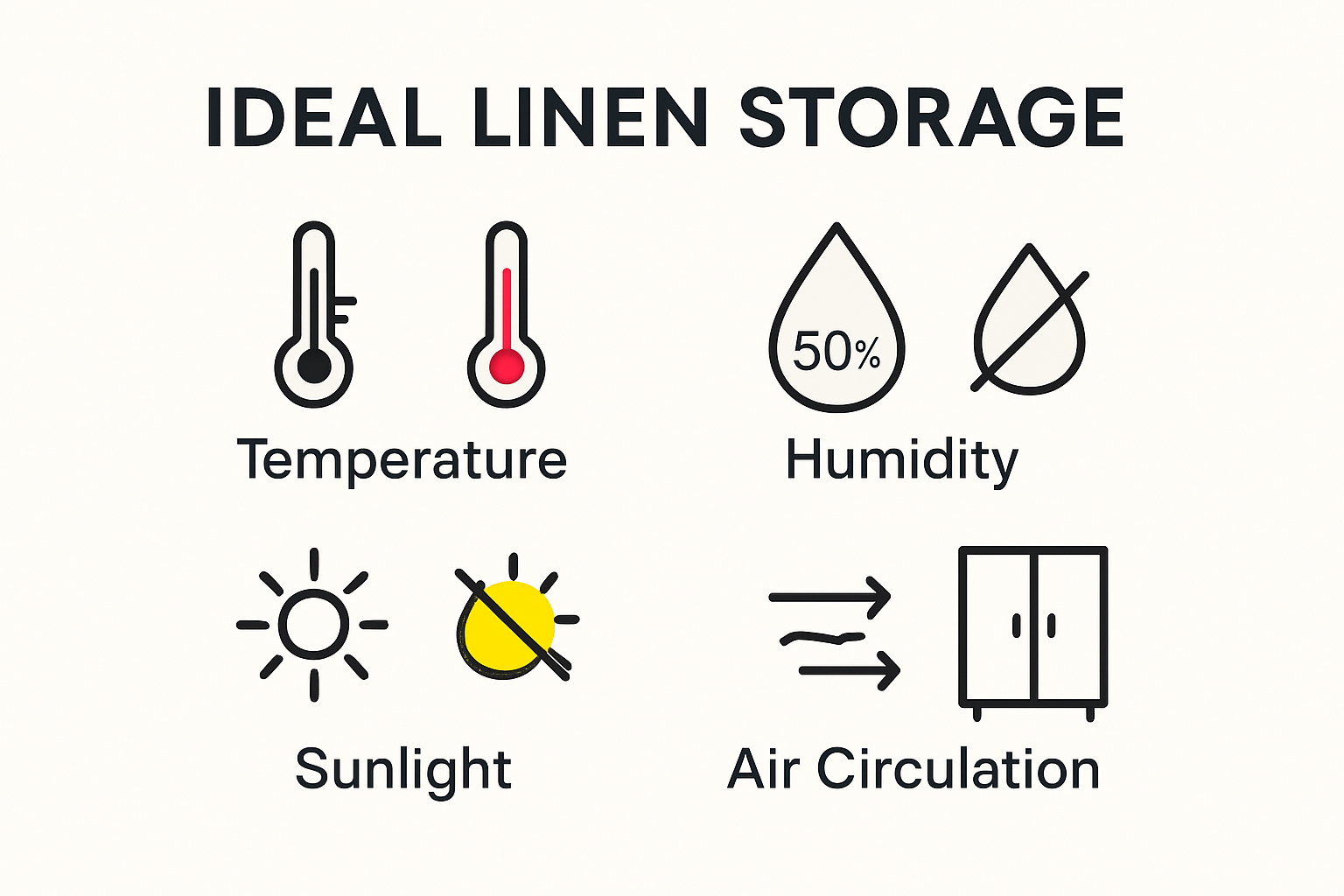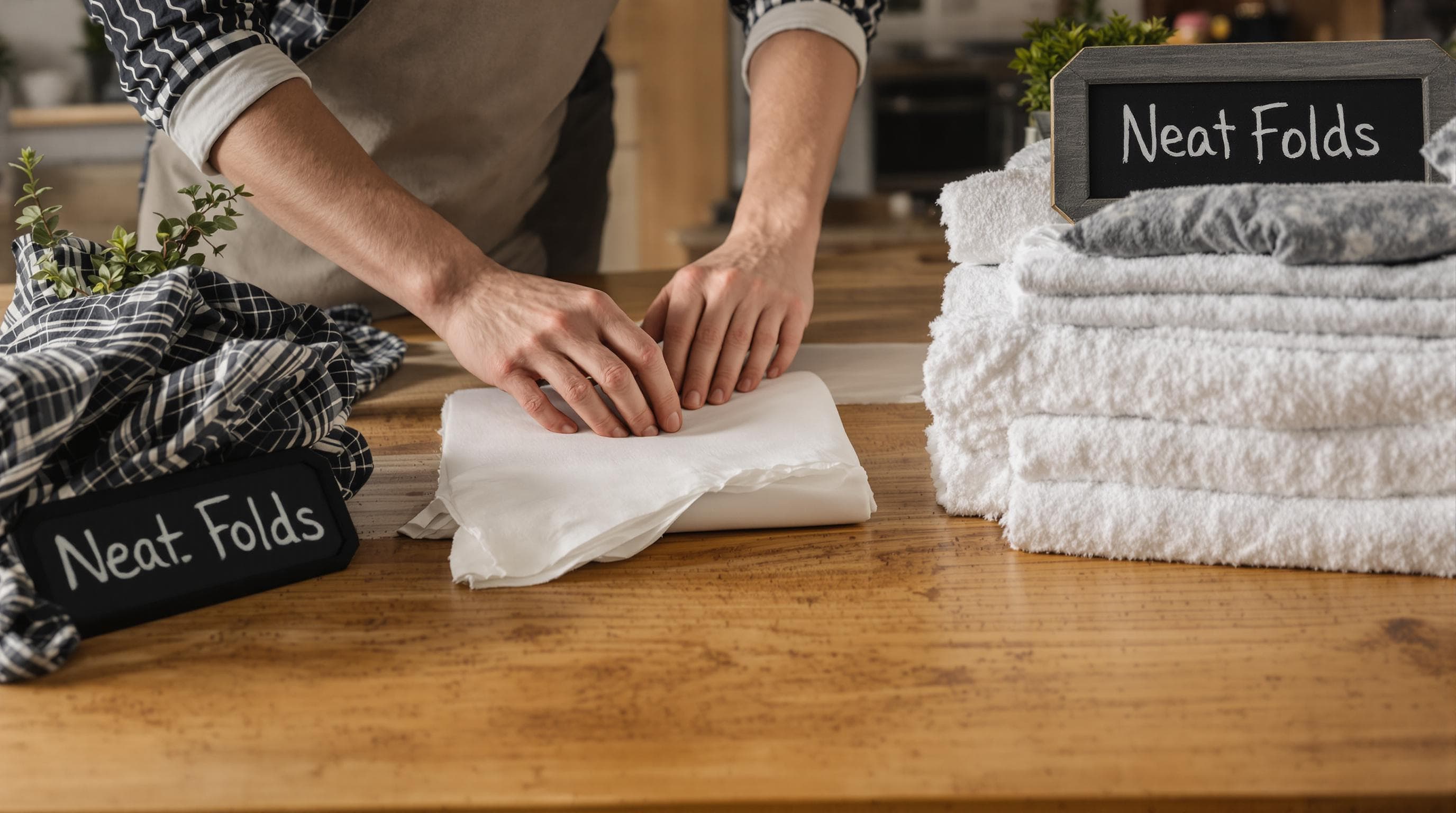

Everyone wants their towels and sheets to stay soft, clean, and smelling fresh. Yet over 60 percent of people admit their linen closet is a cluttered mess or worse, their linens end up ruined by mildew or musty odors. The real game changer isn’t more space or fancy cleaning products. The biggest difference comes from where and how you store them, and just one simple tweak to temperature or folding could keep your linens fresher for years.
Table of Contents
- Choosing The Best Place To Store Linens
- Folding Techniques For Neat Linen Storage
- Creative Solutions For Small Linen Closets
- Keeping Linens Fresh And Ready To Use
Quick Summary
| Takeaway | Explanation |
|---|---|
| Optimal Storage Environment | Maintain a consistent temperature between 65-70°F and 50% humidity to prevent fabric deterioration and musty odors. |
| Effective Folding Techniques | Use uniform folds for linens to maximize storage efficiency, and consider rolling items like bath towels for better space utilization. |
| Creative Use of Space | Maximize vertical and door space in small linen closets with adjustable shelving and over-the-door organizers to enhance accessibility. |
| Moisture and Odor Control | Use breathable containers like cotton bins and incorporate natural deodorizers such as lavender sachets to keep linens fresh. |
| Proper Container Selection | Avoid plastic bags that trap moisture; opt for acid-free boxes that allow airflow while protecting your textiles. |
Choosing the Best Place to Store Linens
When it comes to how to store linens, selecting the right storage location is more than just finding an empty space. Your choice can significantly impact the longevity, quality, and freshness of your textiles. The wrong environment can lead to damage, musty odors, and premature wear.
Temperature and Humidity Considerations
The ideal storage location requires careful attention to environmental conditions. According to the Smithsonian Institution, textiles demand specific storage environments to prevent deterioration. Avoid areas with extreme temperature fluctuations like attics or basements.
Ideal storage spaces should maintain a consistent temperature between 65-70°F with approximately 50% relative humidity. Gaylord Archival emphasizes that high temperatures accelerate fabric breakdown, while excessive humidity promotes mold and insect activity. Consider using a portable dehumidifier in spaces prone to moisture to create optimal storage conditions.

Strategic Storage Location Selection
Select storage areas that offer protection and controlled conditions. Closets in interior rooms often provide the most stable environment. Bedrooms, hallway closets, or dedicated linen storage spaces work best. Avoid direct sunlight, which can fade and weaken fabrics over time.
When organizing your linens, prioritize locations with good air circulation. The George Washington University Museum recommends spaces that prevent moisture buildup and allow fabrics to breathe. If you’re struggling with finding the perfect storage spot, our guide on stylish storage solutions can help you maximize your home’s organizational potential.
Key storage recommendations include:
- Ventilation: Choose areas with consistent airflow
- Temperature Control: Maintain steady, moderate temperatures
- Moisture Management: Use dehumidifiers if necessary
- Protection: Keep linens away from direct sunlight and potential contaminants
By carefully selecting your linen storage location, you’ll preserve the quality, appearance, and longevity of your textiles. The right environment transforms simple storage into a preservation strategy for your valuable home textiles.
To help you quickly compare suitable and unsuitable linen storage locations and their effects, see the table below:
| Storage Location | Environmental Conditions | Suitability | Notes |
|---|---|---|---|
| Interior Closet | Stable temp/humidity, no sun | Recommended | Best protection from light and moisture |
| Bedroom/Hallway Closet | Good air flow, moderate temp | Recommended | Easy accessibility and environmental control |
| Attic | Extreme temperature changes | Not Suitable | Risk of mold, fabric breakdown |
| Basement | High humidity/moisture risk | Not Suitable | Increased potential for mildew and insect activity |
| Direct Sunlight Areas | Heat and UV exposure | Not Suitable | Fading and fabric weakening |
| Laundry Room (well-ventilated) | Good if stable environment | Sometimes OK | Use caution; ensure no excessive humidity |
Folding Techniques for Neat Linen Storage
Mastering how to store linens effectively begins with understanding proper folding techniques. Strategic folding not only saves space but also preserves the quality and appearance of your textiles, transforming cluttered storage into an organized system.
Uniform Folding Methods
Consistent folding creates a neat, streamlined look in your storage spaces. According to The Spruce, rolling large bath towels instead of traditional folding can dramatically save shelf space and make items easier to grab. Professional organizers recommend creating uniform folds that stack perfectly, allowing maximum storage efficiency.
For sheets and pillowcases, develop a standardized folding approach. Start by laying the item flat, smoothing out wrinkles, and folding into thirds lengthwise, then thirds again. This method creates compact, uniform rectangles that stack beautifully and minimize creasing. Arkansas Online suggests storing folded items vertically in drawers, which improves visibility and accessibility.

Special Handling for Delicate Textiles
Delicate linens require extra care during folding and storage. Wikipedia’s textile conservation guide recommends using acid-free tissue paper when folding fragile fabrics to prevent permanent creasing. For extremely delicate items, consider flat storage to provide even support across the fabric.
If you’re looking to optimize your storage strategy even further, our detailed guide on linen organization offers comprehensive insights into creating a perfectly organized textile collection.
Key folding recommendations include:
- Consistency: Create uniform folds for all similar items
- Vertical Storage: Stack items vertically for better visibility
- Gentle Handling: Use soft materials when folding delicate textiles
- Wrinkle Prevention: Smooth fabrics before folding to minimize creases
By implementing these folding techniques, you transform simple storage into an art form. Each carefully folded linen becomes part of a well-organized system that protects your textiles while maximizing available space.
Creative Solutions for Small Linen Closets
Organizing a small linen closet requires creativity, strategic planning, and smart storage solutions. When space is limited, every inch counts, and innovative approaches can transform even the most compact storage areas into efficient textile management systems.
Vertical and Multi-Level Storage Strategies
The Spruce recommends maximizing vertical space as a key strategy for small linen closets. Install adjustable shelving that allows flexible configuration, enabling you to create custom spaces for different textile sizes. Utilize the entire height of your closet by adding extra shelves or hanging organizers near the top and bottom areas often overlooked.
Over-the-door storage solutions can dramatically increase your available space. Lowe’s suggests using specialized hanging organizers for items like extra towels, washcloths, and smaller linens. These solutions transform unused door space into valuable storage real estate, keeping your closet neat and accessible.
Smart Organizational Tools and Techniques
Precision is key when organizing limited spaces. Good Housekeeping recommends using vertical dividers to separate different types of linens, preventing them from becoming a jumbled mess. Repurpose office organizing tools like file sorters to create dedicated sections for washcloths and hand towels.
For those seeking additional organizational inspiration, our expert guide on small space storage offers comprehensive strategies to maximize every square inch of your storage areas.
Key recommendations for small linen closet organization include:
- Vertical Expansion: Use adjustable shelving and door organizers
- Precision Sorting: Implement dividers and dedicated storage sections
- Visibility: Add interior lighting to improve accessibility
- Efficient Folding: Use compact folding techniques to save space
Transforming a small linen closet from chaotic to organized requires thoughtful planning and the right tools. By implementing these creative solutions, you can create a storage system that not only maximizes space but also makes finding and accessing your linens effortless.
Below is a table summarizing smart tools and strategies for organizing small linen closets and their benefits:
| Tool/Strategy | Description | Benefit |
|---|---|---|
| Adjustable Shelving | Moveable shelves for custom fit | Maximizes vertical space |
| Over-the-Door Organizers | Hanging storage on inside closet doors | Adds extra compartments, easy access |
| Vertical Dividers | Separates linens into categories | Prevents mess, organizes by type |
| File Sorters | Repurposed for towels/washcloths | Dedicated storage for small items |
| Interior Lighting | Lights added to closet | Improves visibility and accessibility |
| Compact Folding Techniques | Efficient, uniform folding of all items | Saves shelf and drawer space |
Keeping Linens Fresh and Ready to Use
Maintaining the freshness and quality of your linens requires more than just proper storage. Creating an environment that preserves fabric integrity and prevents unwanted odors or damage is crucial for keeping your textiles in pristine condition.
Moisture and Temperature Control
The Museum of the Albemarle emphasizes the critical role of environmental conditions in textile preservation. Maintain a consistent temperature between 68°F and 75°F, with humidity levels between 40% and 57%. These precise conditions prevent moisture buildup that can lead to mold, mildew, and fabric deterioration.
Homes & Gardens recommends using breathable storage containers like cotton or linen bins. These materials allow air circulation, preventing the musty odors that can develop in sealed plastic containers. Consider adding natural deodorizers like lavender sachets or cedar blocks to keep linens smelling fresh and deter potential pest infestations.
Protective Storage Solutions
Choosing the right storage containers is essential for maintaining linen quality. The Canadian Conservation Institute advises against using plastic garment bags, which can trap moisture and restrict airflow. Instead, opt for acid-free boxes or polyethylene containers that provide protection while allowing fabrics to breathe.
For those looking to elevate their linen care routine, our comprehensive guide to linen storage offers expert insights into maintaining your textiles in top condition.
Key strategies for keeping linens fresh include:
- Breathable Storage: Use natural fiber containers
- Natural Deodorizers: Incorporate lavender or cedar
- Temperature Management: Maintain consistent environmental conditions
- Air Circulation: Avoid airtight storage solutions
Preserving the freshness of your linens is an art that combines careful storage, environmental control, and proactive maintenance. By implementing these strategies, you can ensure your textiles remain soft, clean, and ready to use whenever you need them. The right approach transforms simple storage into a preservation method that extends the life and quality of your beloved linens.
Frequently Asked Questions
How do I store linens to prevent mildew?
To prevent mildew, store linens in a cool, dry place with a consistent temperature between 65-70°F and about 50% humidity. Use breathable containers like cotton bins to allow air circulation.
What is the best way to fold and store linens?
The best way to fold linens is to create uniform rectangles by folding them into thirds lengthwise and then again. Store items vertically for better visibility and accessibility, or consider rolling larger towels to save space.
Should I keep linens in plastic bags?
No, it is not recommended to store linens in plastic bags as they can trap moisture and lead to mildew. Instead, opt for acid-free boxes or breathable fabric containers that allow airflow.
How can I keep my linens smelling fresh?
To keep linens smelling fresh, include natural deodorizers like lavender sachets or cedar blocks in the storage containers. Ensure that the storage environment is dry and well-ventilated to avoid musty odors.
Transform Your Linen Storage from Chaos to Calm
Struggling with linen closets that feel cluttered, cramped, or impossible to keep fresh? You are not alone. As this guide highlights, everyday frustrations like musty odors, messy shelves, and wasted space can make home organization feel impossible. If you want to finally enjoy linens that are soft, neatly folded, and always ready to use, you need solutions built for real homes and busy lives. The Bedroom Storage collection at BLUSHBEES USA is designed to help you create an organized, serene space using breathable bins, smart dividers, and stylish boxes that actually fit your shelves.

Imagine opening your closet to see every towel and sheet stacked perfectly, protected from dust, and smelling fresh every day. Act now and visit https://blushbees.us to discover innovative storage products that bring the article’s expert tips to life. For an extra boost in tricky spots, explore our Underbed Storage to unlock hidden space and gain instant peace of mind. Your dream linen closet can start today—shop solutions that help you breathe easy and stay organized all year long.
Recommended
- The Best way to store Linens and Blankets – BLUSHBEES USA
- 10 Home Organization Tips for a More Tidy and Efficient Living Space – BLUSHBEES USA
- Bedroom Storage tips the Pros use – BLUSHBEES USA
- Best Storage for Blankets: Stylish Solutions for 2025 Homes – BLUSHBEES USA
- Upholstery Fabrics and Cleaning Guide 2025 for Yarra Valley - Yarra Valley Carpet Cleaning
- Base Bed with Storage: Maximizing Space and Style



